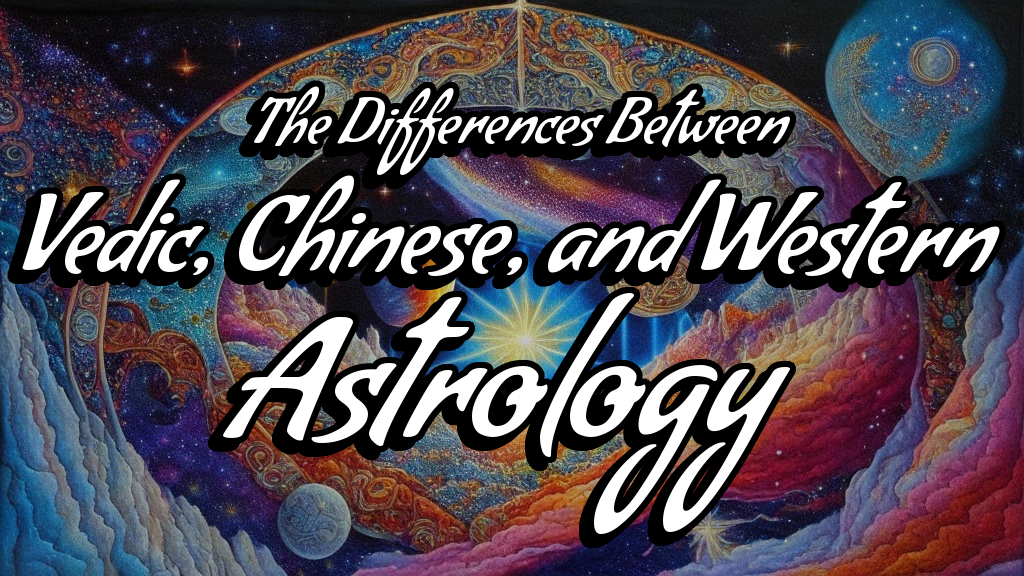Astrology, the study of celestial bodies and their influence on human affairs, has been a part of human culture for thousands of years. From the ancient Sumerians to modern-day astrologers, people have looked to the stars to gain insight into their lives and their place in the cosmos. Over time, distinct astrological systems have emerged, each with its unique approach to understanding the connection between the heavens and human experience. In this article, we’ll delve into the fascinating world of Vedic, Chinese, and Western astrology, exploring their differences, comparing their methodologies, and uncovering the cultural nuances that have shaped these ancient arts. Join us as we embark on a cosmic journey to unveil the tapestry of astrology across cultures.
Vedic Astrology: An Ancient Indian System
Vedic astrology, also known as Jyotish, is an ancient Indian astrological system that traces its roots back to the Vedas, sacred texts of Hinduism that date back over 5000 years. This time-honored tradition is deeply interwoven with Hindu philosophy, spirituality, and Vedic sciences. At its core, Vedic astrology seeks to provide insight into individuals’ lives, focusing on their karma, dharma, and spiritual evolution.
The foundation of Vedic astrology lies in the concept of the natal chart, or birth chart, which is a snapshot of the heavens at the exact moment of an individual’s birth. This chart is divided into twelve houses that represent different aspects of life, such as career, relationships, and health. The placement of the nine planets, or ‘Grahas,’ in these houses determines the individual’s characteristics, challenges, and opportunities. A key feature of Vedic astrology is the use of the Sidereal Zodiac, which takes into account the precession of the Earth’s axis and reflects the actual positions of the constellations in the sky.
Chinese Astrology: A Time-Honored Tradition
Chinese astrology is another ancient system that has been practiced for thousands of years. Rooted in Chinese philosophy, cosmology, and the principles of Yin and Yang, Chinese astrology is a complex and profound system that reflects the intricate interplay between heaven, earth, and humans. Unlike Vedic and Western astrology, Chinese astrology is based on a lunar calendar, with each year associated with one of the twelve animal signs and one of the five elements (wood, fire, earth, metal, and water).
The Chinese astrological system is characterized by its emphasis on the cyclical nature of time and the interconnectedness of all things. The twelve animal signs, which make up the Chinese zodiac, are believed to influence an individual’s personality, relationships, and destiny. These signs are further influenced by the five elements, which govern various aspects of life, such as emotions, health, and career. Chinese astrology also incorporates the concept of the Four Pillars, which takes into account the year, month, day, and hour of birth to provide a comprehensive understanding of an individual’s life path and potential.
Western Astrology: The Popular Zodiac System
Western astrology, the most widely known and practiced system globally, has its origins in ancient Mesopotamia and Egypt. Over the centuries, the art of Western astrology has evolved and adapted, incorporating elements of Greek, Roman, and Hellenistic philosophies. Western astrology is based on the Tropical Zodiac, a fixed celestial coordinate system that uses the vernal equinox as its starting point.
The cornerstone of Western astrology is the natal chart, a map of the sky at the moment of an individual’s birth. This chart is divided into twelve houses that correspond to different areas of life and is populated by the ten planets and their respective signs. Western astrology places great emphasis on the Sun sign, which is determined by the position of the Sun in the zodiac at the time of birth. The Sun sign is believed to represent an individual’s core personality, strengths, and weaknesses.
Key Differences Between Vedic, Chinese, and Western Astrology
While Vedic, Chinese, and Western astrology share a common goal of providing insight into human life and the cosmos, they differ significantly in their methodologies and underlying philosophies. One key difference is the zodiac system used: Vedic astrology employs the Sidereal Zodiac, which reflects the actual positions of the constellations, while Western astrology uses the Tropical Zodiac, a fixed coordinate system. Chinese astrology, on the other hand, is based on a lunar calendar and revolves around the twelve animal signs and the five elements.
Another notable difference lies in the cultural and philosophical underpinnings of these systems. Vedic astrology is deeply rooted in Hindu spirituality and the concepts of karma and dharma, whereas Chinese astrology is grounded in Chinese cosmology and the principles of Yin and Yang. Western astrology, in contrast, is influenced by a diverse array of philosophical traditions and focuses primarily on the individual’s personality and potential.
Astrological Worldviews: How Culture Shapes Interpretation
The unique worldviews and cultural contexts that underpin Vedic, Chinese, and Western astrology are instrumental in shaping the way these systems interpret and apply celestial information. In Vedic astrology, the focus is on understanding the individual’s karma, dharma, and spiritual progress, with an emphasis on self-realization and the attainment of enlightenment. Chinese astrology, on the other hand, emphasizes the interconnectedness of all things and the importance of balance and harmony in life. Western astrology, with its focus on the individual’s personality and potential, seeks to empower individuals to fulfill their unique destiny and realize their highest potential.
Comparative Analysis: Elements, Signs, and Houses
A closer look at the elements, signs, and houses in Vedic, Chinese, and Western astrology reveals both similarities and differences in how these systems approach the celestial sphere. In Vedic astrology, the twelve zodiac signs are associated with the elements of fire, earth, air, and water, which are believed to influence the individual’s temperament and disposition. Similarly, Western astrology assigns each sign to one of the four elements, with the Sun sign playing a central role in determining the individual’s character traits. Chinese astrology, however, employs a different set of elements (wood, fire, earth, metal, and water) and associates them with the twelve animal signs, which correspond to the years in the Chinese lunar calendar.
The concept of houses also varies across these systems. In Vedic astrology, the twelve houses correspond to different aspects of life and are influenced by the placement of the nine planets. Western astrology also utilizes twelve houses, but the focus is on the individual’s experiences and potential in various life areas. Chinese astrology does not employ the concept of houses in the same way, instead relying on the animal signs and the Four Pillars to provide insight into the individual’s life path and destiny.
Predictive Techniques in Vedic, Chinese, and Western Astrology
Each astrological system employs its unique set of predictive techniques to forecast events and provide guidance for individuals. Vedic astrology utilizes a variety of methods, including planetary periods (Dasha system), transits, and harmonic charts to predict future events and identify auspicious and inauspicious times. Chinese astrology relies on the interplay between the animal signs, the five elements, and the Four Pillars to make predictions, with an emphasis on the cyclical nature of time and the importance of aligning with the natural rhythms of the universe. Western astrology employs a range of techniques, such as transits, progressions, and solar returns, to predict future events and provide insight into the individual’s life path and potential.
Astrological Traditions: Preservation and Evolution
Throughout history, the preservation and evolution of Vedic, Chinese, and Western astrology have been shaped by the interplay between cultural continuity and adaptation. These ancient systems have survived and thrived due to the dedication of generations of astrologers who have sought to preserve the wisdom of their ancestors while adapting to the changing contours of human experience. Today, these astrological traditions continue to evolve, incorporating new perspectives and methodologies to remain relevant and resonant in the modern world.
Final Thoughts: Embracing the Cosmic Tapestry of Astrology Across Cultures
Vedic, Chinese, and Western astrology are rich and diverse systems that offer unique insights into the cosmic tapestry that connects us all. By exploring the differences and similarities between these traditions, we can gain a deeper understanding of the astrological philosophies that have shaped human culture and consciousness for millennia. Embracing the wisdom of these ancient arts can enrich our lives, empower us to fulfill our unique destiny, and illuminate our place in the cosmos. Ready to embrace the wisdom of astrology for yourself? Click here to receive a FREE, personalized reading, and discover your role in the cosmic tapestry of the universe today!





